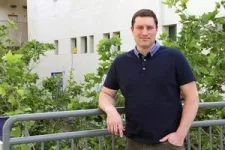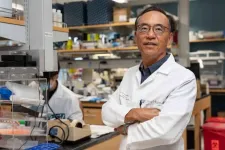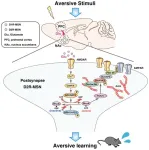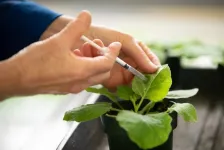(Press-News.org) A new international study provides a shortlist of the wildlife species present at the market from which SARS-CoV-2, the virus responsible for the COVID-19 pandemic, most likely arose in late 2019.
The study, published Thursday in the journal Cell, is based on an analysis of genetic data released by the Chinese Center for Disease Control and Prevention. The data comes from more than 800 samples collected in and around the Huanan Seafood Wholesale market in Wuhan, China, beginning on Jan. 1, 2020, and from viral genomes from early COVID-19 patients.
"This may be the last big, new set of data directly from the market, and in a way, it's like finishing the last piece of a puzzle showing a picture that has been pretty clear already," said Michael Worobey, one of three co-corresponding authors on the paper and head of the Department of Ecology and Evolutionary Biology at the University of Arizona. "We present a thorough and rigorous analysis of the data and how it fits in with the rest of the huge body of evidence we have about how the pandemic started."
On Jan. 1, 2020, just hours after the market closed, investigators from the Chinese CDC went to the market to collect samples. Although they encountered little in the way of live wildlife, they swabbed the floors, walls and other surfaces of many stalls. They came back days later to focus on surfaces in stalls where wildlife was sold, such as a cages and carts used to move animals, and also collected samples from drains and sewers.
They performed metatranscriptomic sequencing of the samples, a technique used to obtain RNA sequences (and which can pick up DNA as well) from all organisms present in the samples – viruses, bacteria, plants, animals and humans. The Chinese CDC team, led by Liu Jun, published its data and results in 2023 in the journal Nature. However, the article left unresolved the exact identities of the animal species found in the data. The Chinese CDC shared the sequencing data on public and open repositories.
According to the latest analysis of the data, SARS-CoV-2 was present in some of the same stalls where wildlife was sold at the market. That wildlife included raccoon dogs – small foxlike animals with markings similar to raccoons – and civet cats – small carnivorous mammals related to mongooses and hyenas. In some cases, genetic material from the SARS-CoV-2 virus and these animals were found on the same swabs.
"Many of the key animal species had been cleared out before the Chinese CDC teams arrived, so we can't have direct proof that the animals were infected," said co-corresponding author Florence Débarre of the French National Centre for Scientific Research. "We are seeing the DNA and RNA ghosts of these animals in the environmental samples, and some are in stalls where SARS-CoV-2 was found, too. This is what you would expect under a scenario in which there were infected animals in the market."
'Spark in a tinderbox'
Putting wild animals with viruses in contact with humans in the heart of big cities, where population densities make it easy for these viruses to take hold, is one of the most risky things humans can do, Worobey said.
"Not all of those viruses have the potential to start a pandemic, but when you do bring them in, it's like a spark in a tinderbox," he said.
The researchers also performed evolutionary analysis of the earliest viral genomes reported in the pandemic. The results imply that there were very few, if any, humans infected prior to the market outbreak. This is consistent with spillovers from animals to humans within the market, then subsequent spread throughout Wuhan and, eventually, the whole world, Worobey said.
While the data cannot prove whether one or more of these animals were infected, the analyses provide a clear list of the species that most likely could have carried the virus.
The study also presents the most complete record of animal species and specific populations within those species that could have acted as intermediate hosts at the market, Worobey said.
"It gives us clues about the populations that were represented there for each species," he said. "Where in Southeast Asia did they live? Where might they have come from? How many were farmed versus wild-caught and then moved into the transportation networks of illegal wildlife?"
Although there has been an increased focus on lab safety since the pandemic began more than four years ago, Worobey says "surprisingly little has been done to decrease the risk of a virus jumping from wildlife into humans again."
"We need to start putting the evidence of how this pandemic started into action by taking serious, concrete action to stop the perilous practice of bringing live animals with potential pandemic pathogens into densely populated urban areas," he said.
END
Samples from Huanan Seafood Market provide further evidence of COVID-19 animal origins
A new analysis co-authored by University of Arizona virus expert Michael Worobey provides additional evidence that wildlife sold illegally at a Chinese market were "ground zero" for the COVID pandemic.
2024-09-19
ELSE PRESS RELEASES FROM THIS DATE:
City of Hope vaccine experts report positive results on Phase 1 trial of personalized vaccine for lymphoplasmacytic lymphoma
2024-09-19
LOS ANGELES — A team of researchers from City of Hope®, one of the largest and most advanced cancer research and treatment organizations in the U.S., and The University of Texas M.D. Anderson Cancer Center, have reported safety and efficacy results from a Phase 1 trial that featured a personalized vaccine to treat lymphoplasmacytic lymphoma, a rare and slow-growing type of blood cancer, according to a study published recently in Nature Communications.
The current approach to lymphoplasmacytic lymphoma care is active surveillance of a patient’s possible symptoms. ...
Global assessment: How to make climate adaptation a success
2024-09-19
Climate change is forcing people to adapt to changing environmental conditions. But what really makes the difference is how they do it. The recently published Hamburg Climate Futures Outlook 2024 by 73 authors shows that, in the long run, only sustainable adaptation can succeed. This global assessment by University of Hamburg’s Cluster of Excellence Climate, Climatic Change, and Society (CLICCS) also provides practical recommendations.
“Successfully adapting to the impacts of climate change is just as difficult and challenging as reducing emissions of every kind,” says Anita Engels, Professor of Sociology ...
The African Engineering and Technology Network signs eighth university partner
2024-09-19
Carnegie Mellon University Africa announced today that the African Engineering and Technology Network (Afretec) has signed its eighth university partner, Al Akhawayn University. The network, launched in 2022, provides a vehicle for technology-focused universities in Africa to engage in deep collaboration to drive inclusive digital growth, create technology development and job growth, and shape policy change.
Afretec Network members span the entire continent and include Carnegie Mellon University Africa, the American University in Cairo, Université Cheikh ...
Researchers awarded $1.14M to use artificial intelligence to determine best rectal cancer treatment strategy
2024-09-19
CLEVELAND—With a new four-year, $1.14 million grant from the U.S. Department of Veterans Affairs, researchers at Case Western Reserve University and the Louis Stokes Cleveland VA Medical Center, will use artificial intelligence (AI) to determine the best personalized treatment for Veterans with rectal cancer.
Colorectal cancers are the third-most common type of cancer in military personnel, affecting up to 8% of Veterans and 5% of active-duty Service members, according to the American Cancer Society (ACS). More than 152,000 patients in the United States will be diagnosed with colorectal cancer in 2024, with more than 46,000 localized ...
A new ventilator-on-a-chip model to study lung damage
2024-09-19
COLUMBUS, Ohio – For the first time, scientists are able to directly compare the different kinds of injury that mechanical ventilation causes to cells in the lungs.
In a new study, using a ventilator-on-a-chip model developed at The Ohio State University, researchers found that shear stress from the collapse and reopening of the air sacs is the most injurious type of damage.
This miniature “organ-on-a-chip” model simulates not only lung injury during mechanical ventilation, but also repair and recovery, in human-derived cells in real time, said co-lead author ...
Enrollment of undocumented students at California universities dropped from 2016 to 2023
2024-09-19
Enrollment of low-income, undocumented students declined by half at University of California and California State University campuses from 2016 through the 2022-23 academic year, according to a new study by the University of California Civil Rights Project at UCLA and UC Davis School of Law.
The paper, “‘California Dreamin’: DACA’s Decline and Undocumented College Student Enrollment in the Golden State” is believed to be the first to report on data collected during an era marked by increasing limitations on DACA, or Deferred Action for Childhood Arrivals.
Further, researchers found, for UC and CSU low-income undocumented ...
Gaining insights into the chemical basis of aversive learning
2024-09-19
One of the things that makes brains so incredibly difficult to understand is their ability to adjust and adapt. Our learning experiences can set off complex signaling cascades that reshape neurons—and their synaptic connections—at the cellular level. For example, in mammals, scientists have established that activation of the N-methyl-D-aspartate receptor (NMDAR) and the ensuing calcium ion (Ca2+)-dependent signaling cascade is essential for postsynaptic remodeling and learning. As one might reasonably expect, ...
Revolutionary visible-light-antenna ligand enhances samarium-catalyzed reactions
2024-09-19
Samarium (Sm), a rare earth metal, is important to organic chemists because of the ability of its divalent compounds to efficiently perform single-electron transfer reductions. Samarium iodide (SmI2) is moderately stable and can operate under mild conditions at room temperature, making it highly useful for producing pharmaceuticals and biologically active materials. However, most reactions require SmI2 in quantities equal to or greater than the stoichiometric amount and necessitate the use of harmful chemicals, making the process resource-intensive and expensive to manage.
Several approaches have been studied to reduce ...
Stopping plants from passing viruses to their progeny
2024-09-19
Scientists have learned how plants keep viruses from being passed to their offspring, a finding that could ensure healthier crops. The discovery could also help reduce the transmission of diseases from mothers to human children.
Plant viruses are often able to spread from one country to another through the seed trade. As a result, parent-to-progeny disease transmission is of global concern.
“Viruses can hide in seeds for years, making this one of the most important issues in agriculture,” said UC Riverside distinguished professor Shou-Wei Ding in the Department of Microbiology and Plant Pathology. Ding is corresponding author of a new paper about the ...
NIH awards $2.8M to Rice, Baylor College of Medicine for research on acute respiratory distress syndrome
2024-09-19
HOUSTON – (Sept. 19, 2024) – Rice University and Baylor College of Medicine have received $2.8 million in funding from the National Heart, Lung, and Blood Institute (NHLBI), a division of the National Institutes of Health (NIH), for research on reducing inflammation and lung damage in acute respiratory distress syndrome (ARDS) patients.
The study, titled “Cell Based Immunomodulation to Suppress Lung Inflammation and Promote Repair,” will be co-led by Omid Veiseh, a professor of bioengineering and faculty director of the Rice Biotech Launch Pad, and Ravi Kiran Ghanta, a professor of surgery at Baylor. ...
LAST 30 PRESS RELEASES:
Adding antibody treatment to chemo boosts outcomes for children with rare cancer
Germline pathogenic variants among women without a history of breast cancer
Tanning beds triple melanoma risk, potentially causing broad DNA damage
Unique bond identified as key to viral infection speed
Indoor tanning makes youthful skin much older on a genetic level
Mouse model sheds new light on the causes and potential solutions to human GI problems linked to muscular dystrophy
The Journal of Nuclear Medicine ahead-of-print tip sheet: December 12, 2025
Smarter tools for peering into the microscopic world
Applications open for funding to conduct research in the Kinsey Institute archives
Global measure underestimates the severity of food insecurity
Child survivors of critical illness are missing out on timely follow up care
Risk-based vs annual breast cancer screening / the WISDOM randomized clinical trial
University of Toronto launches Electric Vehicle Innovation Ontario to accelerate advanced EV technologies and build Canada’s innovation advantage
Early relapse predicts poor outcomes in aggressive blood cancer
American College of Lifestyle Medicine applauds two CMS models aligned with lifestyle medicine practice and reimbursement
Clinical trial finds cannabis use not a barrier to quitting nicotine vaping
Supplemental nutrition assistance program policies and food insecurity
Switching immune cells to “night mode” could limit damage after a heart attack, study suggests
URI-based Global RIghts Project report spotlights continued troubling trends in worldwide inhumane treatment
Neutrophils are less aggressive at night, explaining why nighttime heart attacks cause less damage than daytime events
Menopausal hormone therapy may not pose breast cancer risk for women with BRCA mutations
Mobile health tool may improve quality of life for adolescent and young adult breast cancer survivors
Acupuncture may help improve perceived breast cancer-related cognitive difficulties over usual care
Nerve block may reduce opioid use in infants undergoing cleft palate surgery
CRISPR primes goldenberry for fruit bowl fame
Mass General Brigham announces new AI company to accelerate clinical trial screening and patient recruitment
Fat tissue around the heart may contribute to greater heart injury after a heart attack
Jeonbuk National University researcher proposes a proposing a two-stage decision-making framework of lithium governance in Latin America
Chromatin accessibility maps reveal how stem cells drive myelodysplastic progression
Cartilaginous cells regulate growth and blood vessel formation in bones
[Press-News.org] Samples from Huanan Seafood Market provide further evidence of COVID-19 animal originsA new analysis co-authored by University of Arizona virus expert Michael Worobey provides additional evidence that wildlife sold illegally at a Chinese market were "ground zero" for the COVID pandemic.








